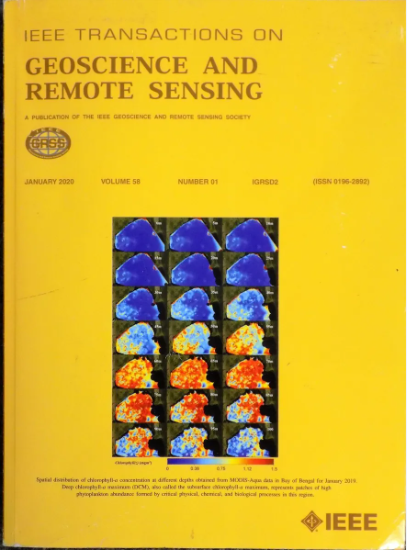Cloud-Cleared Radiances From Collocated Observations of Hyperspectral IR Sounder and Advanced Imager Onboard the Same Geostationary Platform
IF 7.5
1区 地球科学
Q1 ENGINEERING, ELECTRICAL & ELECTRONIC
IEEE Transactions on Geoscience and Remote Sensing
Pub Date : 2024-09-11
DOI:10.1109/TGRS.2024.3458093
引用次数: 0
Abstract
The Geostationary Interferometric Infrared Sounder (GIIRS) onboard China’s Fengyun-4A (FY-4A) geostationary (GEO) meteorological satellite provides high-spectral-resolution infrared (IR) observations for targeted observing areas with high temporal resolution. Due to the high uncertainties in radiative transfer modeling of cloudy radiances, it is challenging to take full advantage of the thermodynamic information from GIIRS in all-sky conditions. The Advanced Geostationary Radiation Imager (AGRI) onboard the same platform provides a variety of cloud products with high spatial resolution. A bias-corrected optimal cloud-clearing (BCOCC) approach is introduced to generate GIIRS cloud-cleared radiances (CCRs) with the help of AGRI-collocated clear radiances (CLRs). The bias correction (BC) scheme is based on the inter-comparisons between GIIRS and AGRI for each field-of-view (FOV) and different scene temperatures. The BC method ensures the radiometric consistency between GIIRS and AGRI. Evaluations of GIIRS CCRs show that the mean biases are 0.09, −0.06, and 0.06 K when compared with the three AGRI IR bands, B12, B13, and B14. In addition, BCOCC significantly increases the data yields of successful CCRs by three times that of the optimal cloud-clearing (OCC) approach without BC. For 15 days from September 16–30, 2021, around 37% more GIIRS partially cloudy footprints than clear sky are cloud cleared successfully. The CCRs can be assimilated as CLRs in numerical weather prediction (NWP) models without worrying about the cloud impact. This study provides evidence of the importance of placing an advanced hyperspectral IR sounder and imager onboard the same GEO platform for better quantitative applications.在同一地球静止平台上对高光谱红外探测仪和高级成像仪进行协同观测得出的云清除辐射率
中国风云四号 A(FY-4A)地球静止气象卫星上搭载的地球静止干涉红外探测器(GIIRS)为目标观测区域提供了高时间分辨率的高光谱分辨率红外观测数据。由于多云辐射的辐射传递建模存在很大的不确定性,在全天空条件下充分利用 GIIRS 提供的热力学信息具有挑战性。同一平台上的高级地球静止辐射成像仪(AGRI)提供了多种高空间分辨率的云产品。在 AGRI-定位清晰辐射(CLRs)的帮助下,引入了一种偏差校正优化云清除(BCOCC)方法来生成 GIIRS 云清除辐射(CCRs)。偏差校正(BC)方案基于 GIIRS 和 AGRI 对每个视场(FOV)和不同场景温度的相互比较。BC 方法可确保 GIIRS 和 AGRI 之间辐射测量的一致性。对 GIIRS CCR 的评估表明,与 AGRI 的三个红外波段 B12、B13 和 B14 相比,平均偏差分别为 0.09、-0.06 和 0.06 K。此外,BCOCC 使成功 CCR 的数据产量大幅提高,是不使用 BC 的最优清云 (OCC) 方法的三倍。在 2021 年 9 月 16 日至 30 日的 15 天内,成功清除云层的 GIIRS 部分多云足迹比晴空多出约 37%。在数值天气预报(NWP)模式中,CCR 可被同化为 CLR,而无需担心云的影响。这项研究证明了在同一个地球同步轨道平台上安装先进的高光谱红外探测仪和成像仪以实现更好的定量应用的重要性。
本文章由计算机程序翻译,如有差异,请以英文原文为准。
求助全文
约1分钟内获得全文
求助全文
来源期刊

IEEE Transactions on Geoscience and Remote Sensing
工程技术-地球化学与地球物理
CiteScore
11.50
自引率
28.00%
发文量
1912
审稿时长
4.0 months
期刊介绍:
IEEE Transactions on Geoscience and Remote Sensing (TGRS) is a monthly publication that focuses on the theory, concepts, and techniques of science and engineering as applied to sensing the land, oceans, atmosphere, and space; and the processing, interpretation, and dissemination of this information.
 求助内容:
求助内容: 应助结果提醒方式:
应助结果提醒方式:


